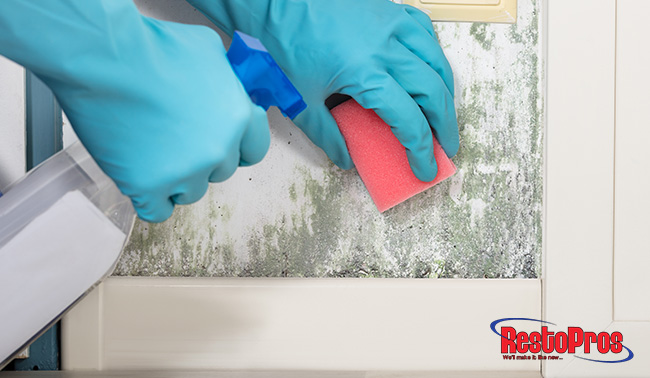
September is Mold Awareness Month and RestoPros wants to empower our Dallas/Ft. Worth neighbors with the latest information on its effects. Our wet and humid summer put us on alert with several blogs on the prevention and detection of mold in the home. We deal directly with mold every day, so we know how drastically it can affect both a home and a household. From the devastation that mold infestation can cause to the adverse health effects of a household, we have seen it all.
Keeping it from developing requires a combination of proper humidity and temperatures levels – as well as healthy air circulation and ventilation. The Centers for Disease Control and Prevention (CDC) released a thorough review of residential mold infestation, its effects on people and how it can be controlled and prevented. RestoPros thought it would be helpful to share this information during Mold Awareness Month. While we have covered many of their findings in our recent blogs, having the CDC back up the information with their thorough research gives weight to the conversation.
This information was taken directly from their Facts about Mold and Dampness report, a thorough analysis of the subject.
Main Health Points:
Mold affects people differently – and some people are not affected at all by its presence.
- Exposure to damp and moldy environments can cause a variety of health problems (or effects) or none at all.
- Some people are sensitive to mold and can develop nasal stuffiness, throat irritation, coughing or wheezing, eye irritation and (sometimes) skin irritation.
- People with mold allergies can have more severe reactions. Immune compromised people and people with chronic lung illnesses can get serious infections in their lungs when exposed to mold.
- According to the Institute of Medicine (IOM), there is sufficient evidence linking indoor exposure to mold with: upper respiratory tract symptoms including coughing and wheezing in otherwise healthy people; asthma symptoms in people with asthma; and with hypersensitivity pneumonitis in individuals susceptible to that immune-mediated condition.
- The IOM also found limited or suggestive evidence linking indoor mold exposure and respiratory illness in otherwise healthy children.
Mold Control and Prevention:
If mold is growing in your home you need to clean up the mold and fix the moisture problem.
- You can help control mold by keeping the humidity levels in your home at a healthy percentage (around 40 – 50%). An air conditioner or dehumidifier can help you keep the level low.
- Promptly fix leaky roofs, windows, and pipes so mold does not have the moisture to grow.
- Thoroughly clean and dry rooms (within 24-48 hours) after flooding.
- Make sure that your home has enough ventilation. Ventilate bathroom, laundry and kitchen/cooking areas.
- Add mold inhibitors to paints before painting.
- Clean bathrooms with mold-killing products.
- Remove or replace carpets and upholstery that have bene soaked and cannot be dried promptly. Try not to use carpet in rooms like bathrooms or basements that may have a lot of moisture.
The EPA’s A Brief Guide to Mold, Moisture and Your Home
If you are dealing with a mold problem in your home, simply cleaning up the evidence is not sufficient. While certain molds may not be as destructive as others, its presence means that there is a moisture source in your home that needs to be fixed. RestoPros can help with all facets of a mold infestation including testing and remediation. Call us at 855-587-3786 to schedule an appointment today!
Related Blogs:
Areas in the Home to Check for Mold
Natural Mold and Mildew Removal
